Examining Profit Business Structures: Advantages, Disadvantages & Uses
VerifiedAdded on 2023/05/29
|10
|1653
|169
Essay
AI Summary
This essay provides a comprehensive analysis of various profit business structures, including sole proprietorships, partnerships, and limited companies, detailing their respective advantages and disadvantages. It examines aspects such as control, financial implications, liability, decision-making processes, funding, flexibility, and taxation. Furthermore, the essay identifies and discusses the main users of accounting information, including owners, managers, employees, government entities, the general public, industrial consumers, investors, and lenders, explaining how each group utilizes this information to assess business performance, make informed decisions, ensure compliance, and evaluate financial health and stability. The conclusion emphasizes the importance of understanding different business structures and the critical role of accounting information in meeting the diverse needs of stakeholders.

BUSINESS MANAGEMENT
Student’s Name
Course Name
Professor’s Name
University Name
City, State
Date
Student’s Name
Course Name
Professor’s Name
University Name
City, State
Date
Paraphrase This Document
Need a fresh take? Get an instant paraphrase of this document with our AI Paraphraser

Introduction
Determination of the type of structure for a business is one of the first steps taken by
individuals wanting to start businesses. Multiple business structures are available for new
businesses including partnerships, sole proprietorships, and limited companies. Each of these is
characterized by unique tax and legal ramifications. There are also advantages and disadvantages
of different business structures. This paper will discuss the advantages and disadvantages of
profit business structures and explain how accounting information is used by different users.
a. Explain three Advantages and disadvantages for Profit business structures
Sole trader
A sole trader refers to a business structure where a business is exclusively owned and run
by a single individual. The business entity is not distinguishable from the owner (Nickels,
McHugh and McHugh, 2008).
Advantages of a sole trader
Exclusive control
A sole has exclusive control of the business entity. They run their business on their
own(Carlon, Mladenovic, Palm and Waters, 2011)..
Profits retention
A sole trader keeps all profits after tax deductions have been made. They do not have to share
their profits with anyone (Carlon, Mladenovic, Palm and Waters, 2011).
Low startup cost
Determination of the type of structure for a business is one of the first steps taken by
individuals wanting to start businesses. Multiple business structures are available for new
businesses including partnerships, sole proprietorships, and limited companies. Each of these is
characterized by unique tax and legal ramifications. There are also advantages and disadvantages
of different business structures. This paper will discuss the advantages and disadvantages of
profit business structures and explain how accounting information is used by different users.
a. Explain three Advantages and disadvantages for Profit business structures
Sole trader
A sole trader refers to a business structure where a business is exclusively owned and run
by a single individual. The business entity is not distinguishable from the owner (Nickels,
McHugh and McHugh, 2008).
Advantages of a sole trader
Exclusive control
A sole has exclusive control of the business entity. They run their business on their
own(Carlon, Mladenovic, Palm and Waters, 2011)..
Profits retention
A sole trader keeps all profits after tax deductions have been made. They do not have to share
their profits with anyone (Carlon, Mladenovic, Palm and Waters, 2011).
Low startup cost
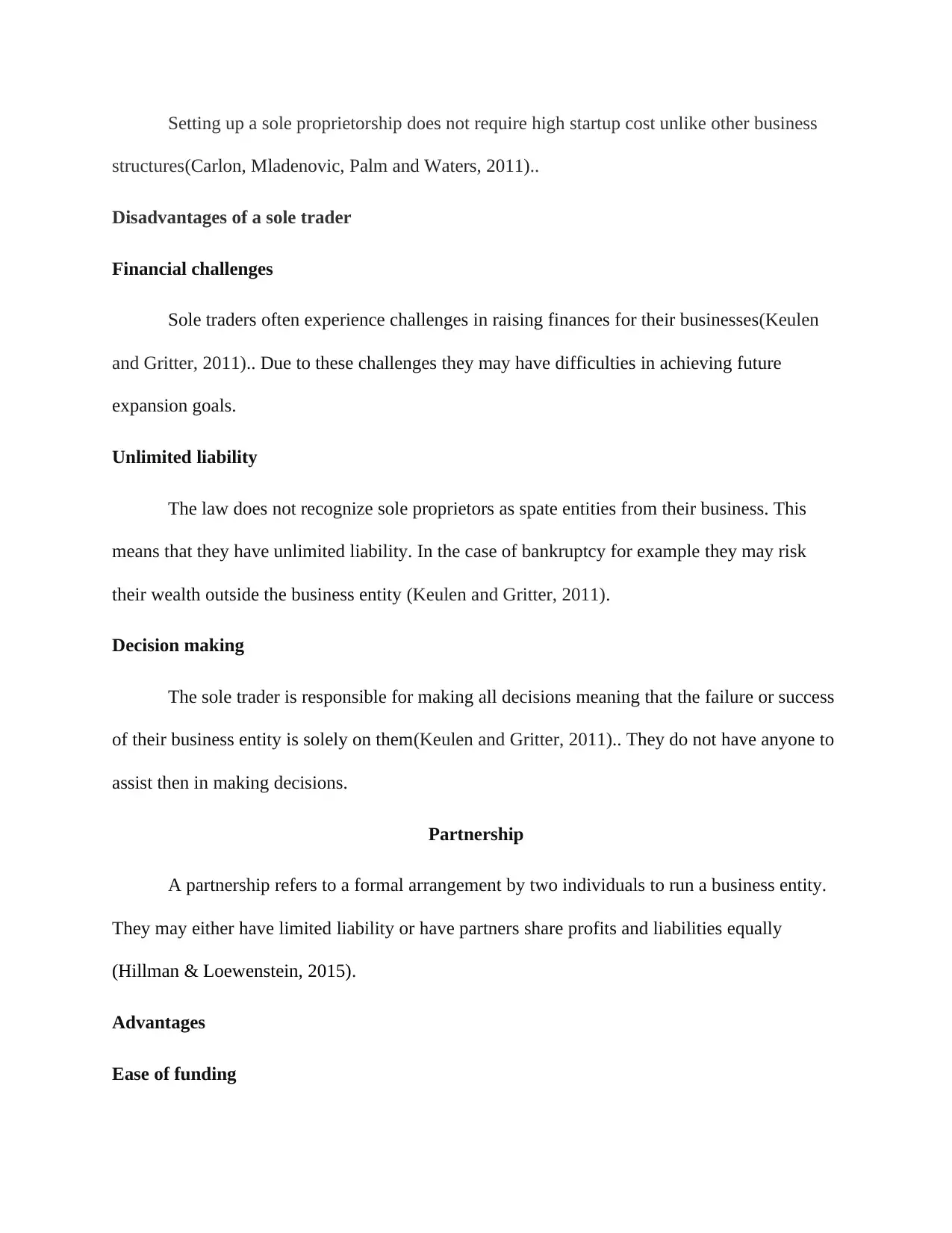
Setting up a sole proprietorship does not require high startup cost unlike other business
structures(Carlon, Mladenovic, Palm and Waters, 2011)..
Disadvantages of a sole trader
Financial challenges
Sole traders often experience challenges in raising finances for their businesses(Keulen
and Gritter, 2011).. Due to these challenges they may have difficulties in achieving future
expansion goals.
Unlimited liability
The law does not recognize sole proprietors as spate entities from their business. This
means that they have unlimited liability. In the case of bankruptcy for example they may risk
their wealth outside the business entity (Keulen and Gritter, 2011).
Decision making
The sole trader is responsible for making all decisions meaning that the failure or success
of their business entity is solely on them(Keulen and Gritter, 2011).. They do not have anyone to
assist then in making decisions.
Partnership
A partnership refers to a formal arrangement by two individuals to run a business entity.
They may either have limited liability or have partners share profits and liabilities equally
(Hillman & Loewenstein, 2015).
Advantages
Ease of funding
structures(Carlon, Mladenovic, Palm and Waters, 2011)..
Disadvantages of a sole trader
Financial challenges
Sole traders often experience challenges in raising finances for their businesses(Keulen
and Gritter, 2011).. Due to these challenges they may have difficulties in achieving future
expansion goals.
Unlimited liability
The law does not recognize sole proprietors as spate entities from their business. This
means that they have unlimited liability. In the case of bankruptcy for example they may risk
their wealth outside the business entity (Keulen and Gritter, 2011).
Decision making
The sole trader is responsible for making all decisions meaning that the failure or success
of their business entity is solely on them(Keulen and Gritter, 2011).. They do not have anyone to
assist then in making decisions.
Partnership
A partnership refers to a formal arrangement by two individuals to run a business entity.
They may either have limited liability or have partners share profits and liabilities equally
(Hillman & Loewenstein, 2015).
Advantages
Ease of funding
⊘ This is a preview!⊘
Do you want full access?
Subscribe today to unlock all pages.

Trusted by 1+ million students worldwide
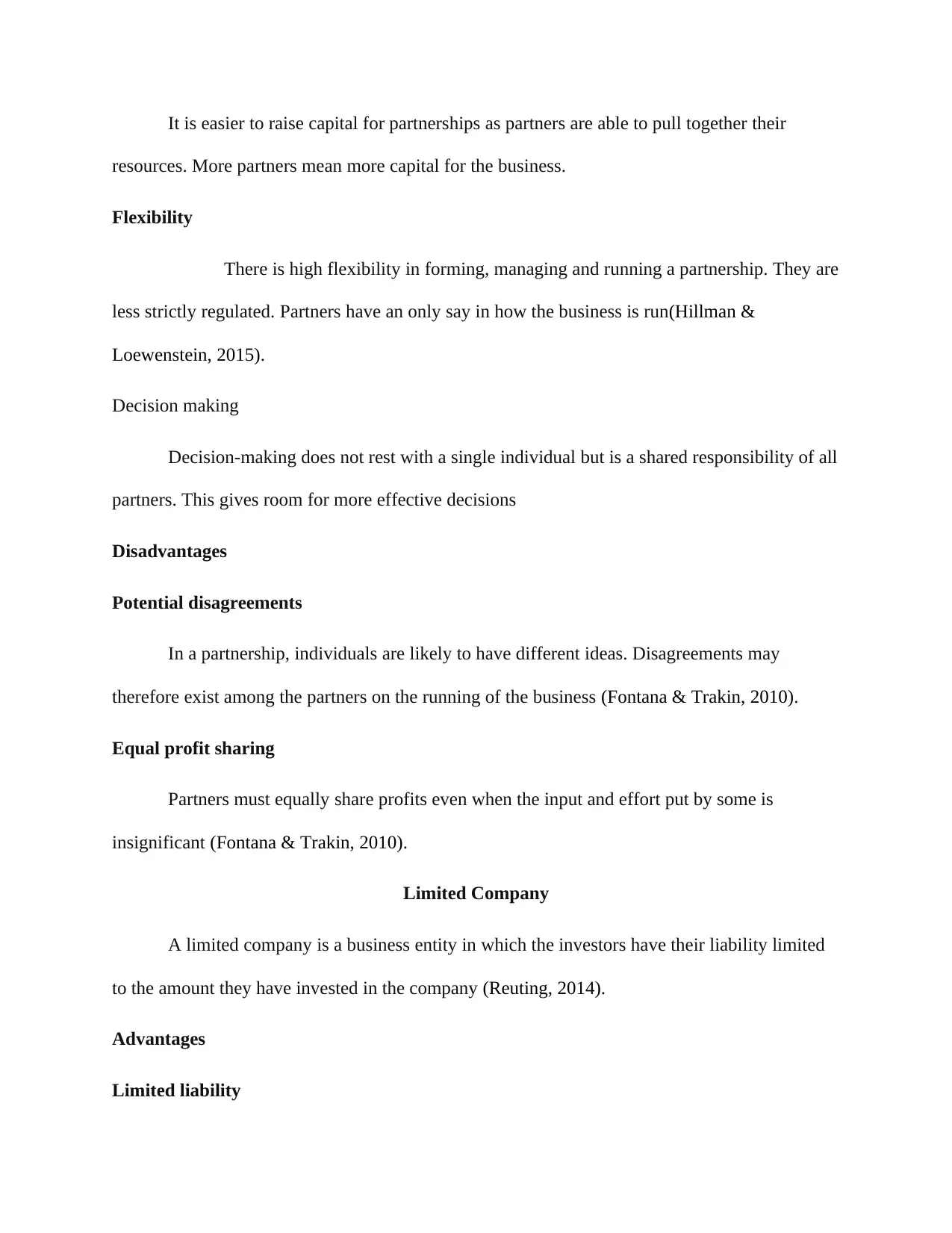
It is easier to raise capital for partnerships as partners are able to pull together their
resources. More partners mean more capital for the business.
Flexibility
There is high flexibility in forming, managing and running a partnership. They are
less strictly regulated. Partners have an only say in how the business is run(Hillman &
Loewenstein, 2015).
Decision making
Decision-making does not rest with a single individual but is a shared responsibility of all
partners. This gives room for more effective decisions
Disadvantages
Potential disagreements
In a partnership, individuals are likely to have different ideas. Disagreements may
therefore exist among the partners on the running of the business (Fontana & Trakin, 2010).
Equal profit sharing
Partners must equally share profits even when the input and effort put by some is
insignificant (Fontana & Trakin, 2010).
Limited Company
A limited company is a business entity in which the investors have their liability limited
to the amount they have invested in the company (Reuting, 2014).
Advantages
Limited liability
resources. More partners mean more capital for the business.
Flexibility
There is high flexibility in forming, managing and running a partnership. They are
less strictly regulated. Partners have an only say in how the business is run(Hillman &
Loewenstein, 2015).
Decision making
Decision-making does not rest with a single individual but is a shared responsibility of all
partners. This gives room for more effective decisions
Disadvantages
Potential disagreements
In a partnership, individuals are likely to have different ideas. Disagreements may
therefore exist among the partners on the running of the business (Fontana & Trakin, 2010).
Equal profit sharing
Partners must equally share profits even when the input and effort put by some is
insignificant (Fontana & Trakin, 2010).
Limited Company
A limited company is a business entity in which the investors have their liability limited
to the amount they have invested in the company (Reuting, 2014).
Advantages
Limited liability
Paraphrase This Document
Need a fresh take? Get an instant paraphrase of this document with our AI Paraphraser

A limited liability company comes with limited liability for stakeholders. In case of
bankruptcy, they will only lose an amount equivalent to their investment in the company
(Reuting, 2014).
Separate entity
Legally, a limited company is considered to be a separate entity from its shareholders
(Reuting, 2014).
Taxation
In Limited companies, only profits are taxed. They also do not attract high personal taxes
as sole traders and partnerships (Reuting, 2014).
Disadvantages
Corporation taxes
Limited companies are liable for corporation taxes, which are taxed on the business’s profits
(Muchlinski, 2010).
Administration responsibilities
Administration details that organizations need to take care of every month include
business accounts, expense details and tax returns (Muchlinski, 2010).
Limited privacy
A Limited company is required to disclose certain information to the public (Muchlinski,
2010).
bankruptcy, they will only lose an amount equivalent to their investment in the company
(Reuting, 2014).
Separate entity
Legally, a limited company is considered to be a separate entity from its shareholders
(Reuting, 2014).
Taxation
In Limited companies, only profits are taxed. They also do not attract high personal taxes
as sole traders and partnerships (Reuting, 2014).
Disadvantages
Corporation taxes
Limited companies are liable for corporation taxes, which are taxed on the business’s profits
(Muchlinski, 2010).
Administration responsibilities
Administration details that organizations need to take care of every month include
business accounts, expense details and tax returns (Muchlinski, 2010).
Limited privacy
A Limited company is required to disclose certain information to the public (Muchlinski,
2010).
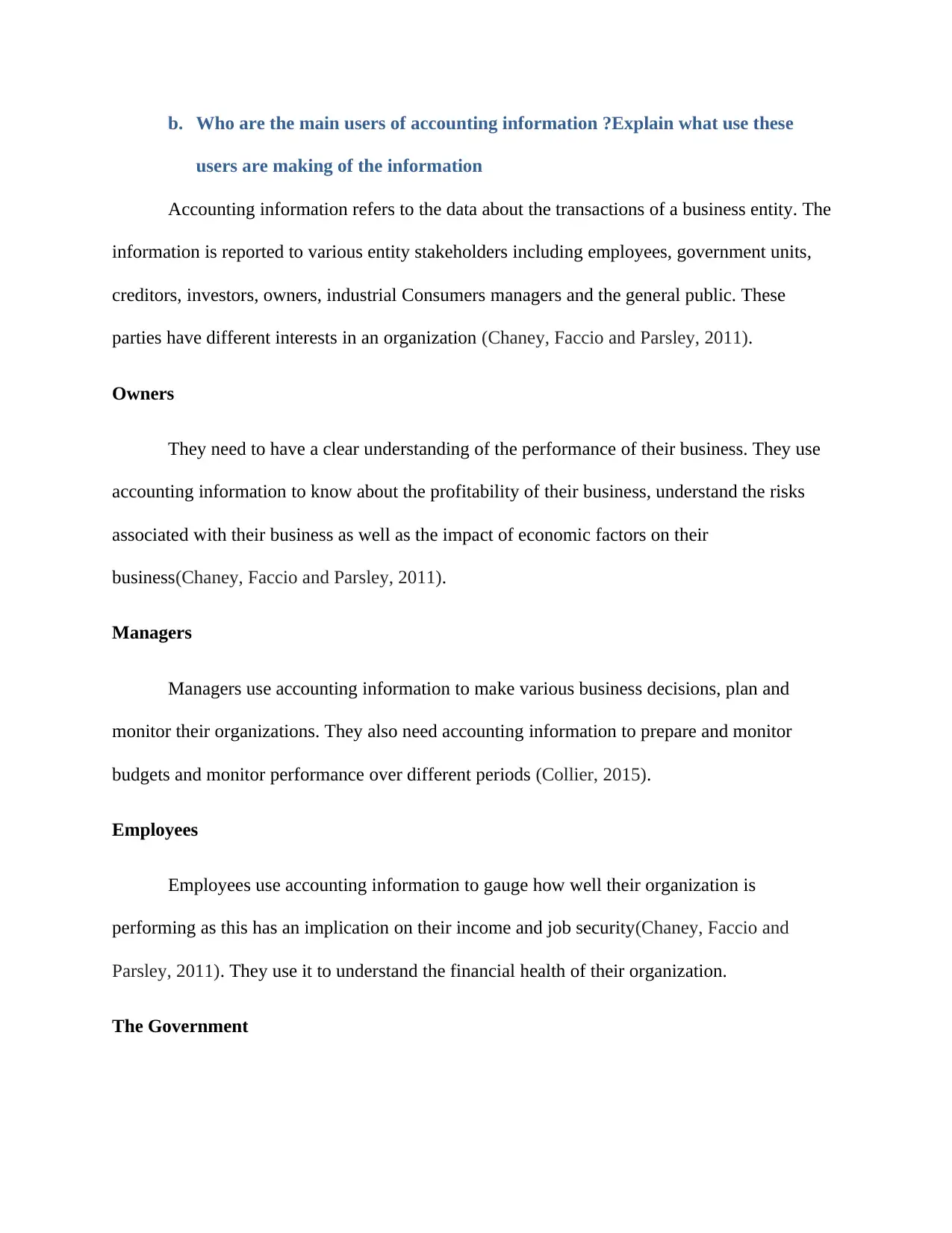
b. Who are the main users of accounting information ?Explain what use these
users are making of the information
Accounting information refers to the data about the transactions of a business entity. The
information is reported to various entity stakeholders including employees, government units,
creditors, investors, owners, industrial Consumers managers and the general public. These
parties have different interests in an organization (Chaney, Faccio and Parsley, 2011).
Owners
They need to have a clear understanding of the performance of their business. They use
accounting information to know about the profitability of their business, understand the risks
associated with their business as well as the impact of economic factors on their
business(Chaney, Faccio and Parsley, 2011).
Managers
Managers use accounting information to make various business decisions, plan and
monitor their organizations. They also need accounting information to prepare and monitor
budgets and monitor performance over different periods (Collier, 2015).
Employees
Employees use accounting information to gauge how well their organization is
performing as this has an implication on their income and job security(Chaney, Faccio and
Parsley, 2011). They use it to understand the financial health of their organization.
The Government
users are making of the information
Accounting information refers to the data about the transactions of a business entity. The
information is reported to various entity stakeholders including employees, government units,
creditors, investors, owners, industrial Consumers managers and the general public. These
parties have different interests in an organization (Chaney, Faccio and Parsley, 2011).
Owners
They need to have a clear understanding of the performance of their business. They use
accounting information to know about the profitability of their business, understand the risks
associated with their business as well as the impact of economic factors on their
business(Chaney, Faccio and Parsley, 2011).
Managers
Managers use accounting information to make various business decisions, plan and
monitor their organizations. They also need accounting information to prepare and monitor
budgets and monitor performance over different periods (Collier, 2015).
Employees
Employees use accounting information to gauge how well their organization is
performing as this has an implication on their income and job security(Chaney, Faccio and
Parsley, 2011). They use it to understand the financial health of their organization.
The Government
⊘ This is a preview!⊘
Do you want full access?
Subscribe today to unlock all pages.

Trusted by 1+ million students worldwide
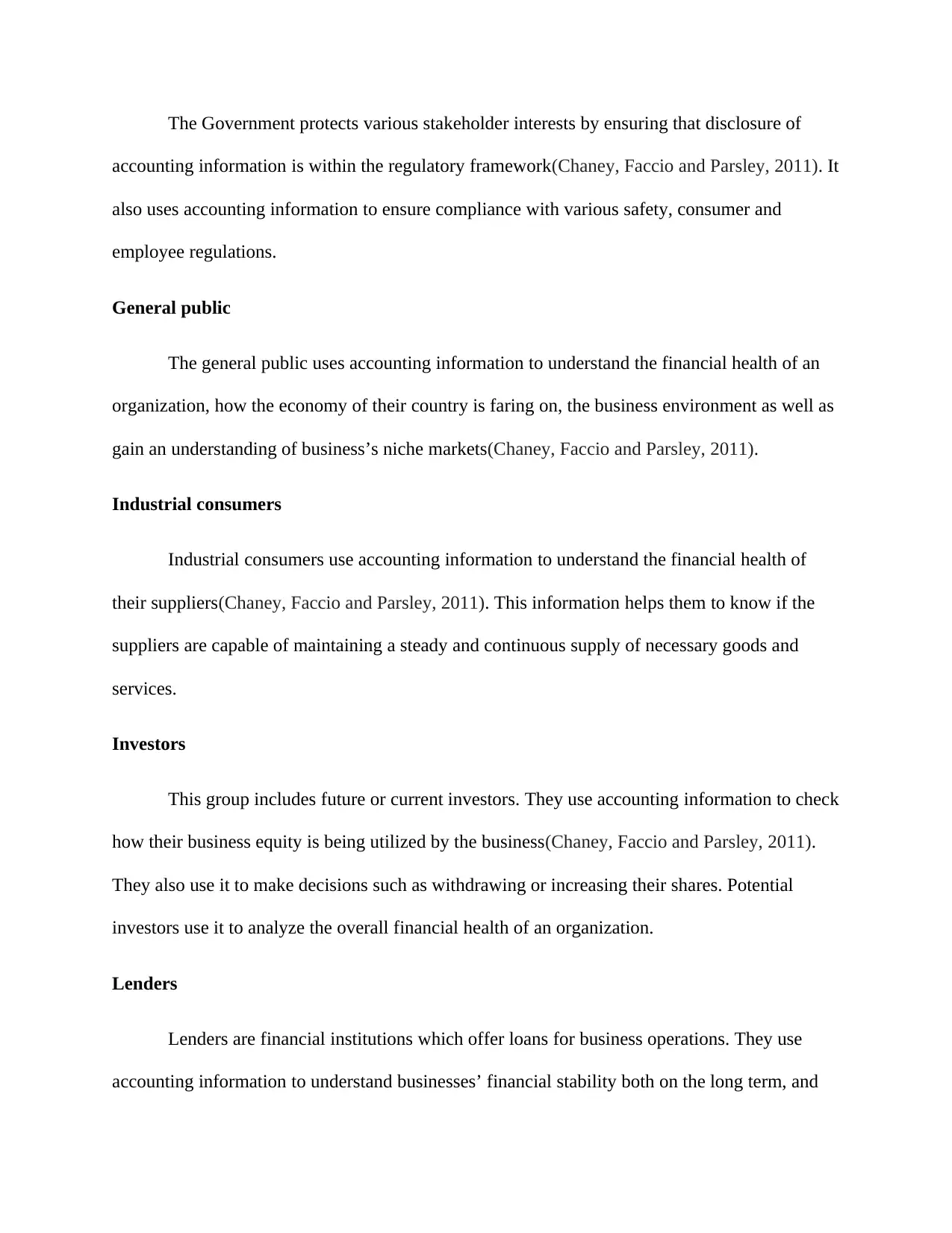
The Government protects various stakeholder interests by ensuring that disclosure of
accounting information is within the regulatory framework(Chaney, Faccio and Parsley, 2011). It
also uses accounting information to ensure compliance with various safety, consumer and
employee regulations.
General public
The general public uses accounting information to understand the financial health of an
organization, how the economy of their country is faring on, the business environment as well as
gain an understanding of business’s niche markets(Chaney, Faccio and Parsley, 2011).
Industrial consumers
Industrial consumers use accounting information to understand the financial health of
their suppliers(Chaney, Faccio and Parsley, 2011). This information helps them to know if the
suppliers are capable of maintaining a steady and continuous supply of necessary goods and
services.
Investors
This group includes future or current investors. They use accounting information to check
how their business equity is being utilized by the business(Chaney, Faccio and Parsley, 2011).
They also use it to make decisions such as withdrawing or increasing their shares. Potential
investors use it to analyze the overall financial health of an organization.
Lenders
Lenders are financial institutions which offer loans for business operations. They use
accounting information to understand businesses’ financial stability both on the long term, and
accounting information is within the regulatory framework(Chaney, Faccio and Parsley, 2011). It
also uses accounting information to ensure compliance with various safety, consumer and
employee regulations.
General public
The general public uses accounting information to understand the financial health of an
organization, how the economy of their country is faring on, the business environment as well as
gain an understanding of business’s niche markets(Chaney, Faccio and Parsley, 2011).
Industrial consumers
Industrial consumers use accounting information to understand the financial health of
their suppliers(Chaney, Faccio and Parsley, 2011). This information helps them to know if the
suppliers are capable of maintaining a steady and continuous supply of necessary goods and
services.
Investors
This group includes future or current investors. They use accounting information to check
how their business equity is being utilized by the business(Chaney, Faccio and Parsley, 2011).
They also use it to make decisions such as withdrawing or increasing their shares. Potential
investors use it to analyze the overall financial health of an organization.
Lenders
Lenders are financial institutions which offer loans for business operations. They use
accounting information to understand businesses’ financial stability both on the long term, and
Paraphrase This Document
Need a fresh take? Get an instant paraphrase of this document with our AI Paraphraser
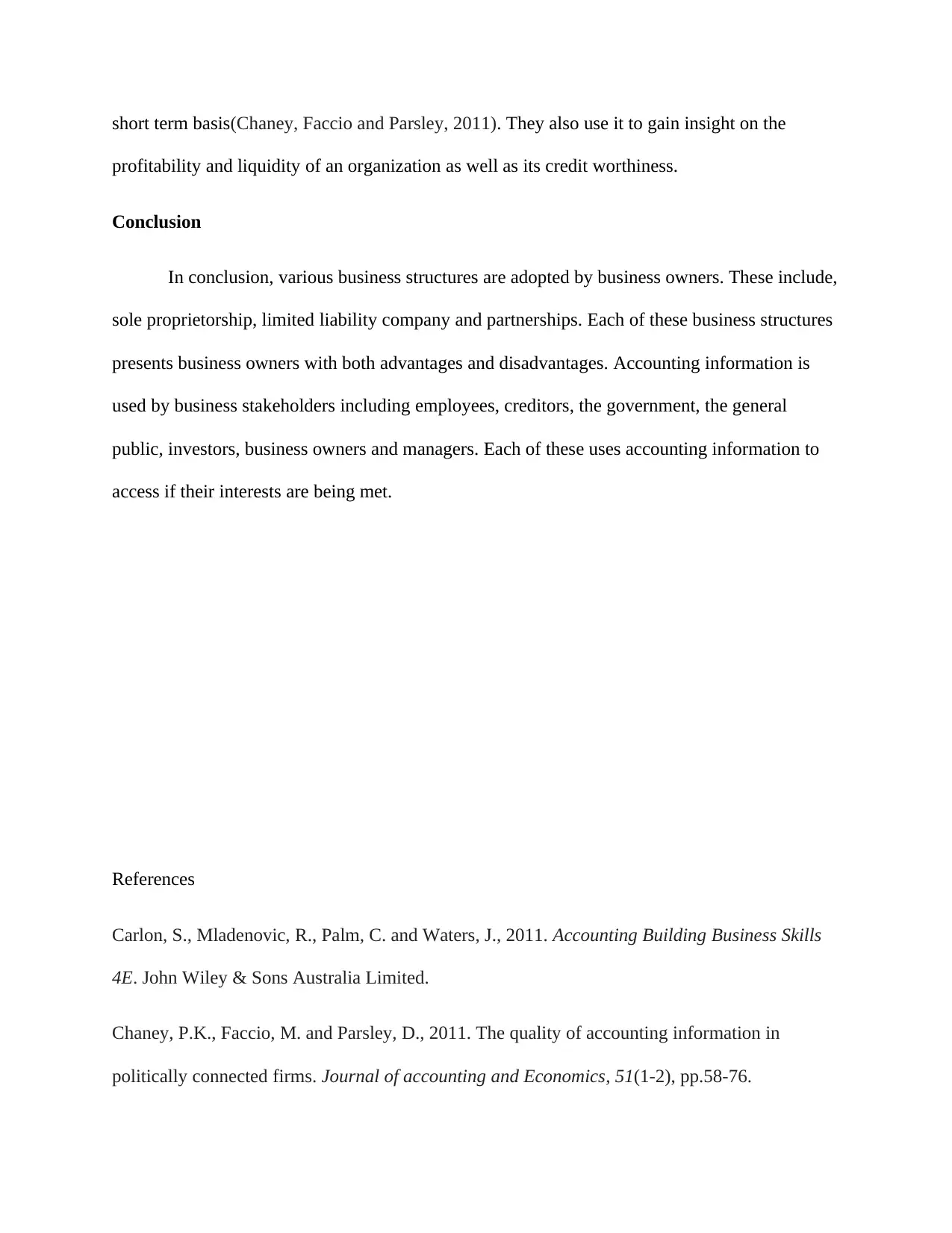
short term basis(Chaney, Faccio and Parsley, 2011). They also use it to gain insight on the
profitability and liquidity of an organization as well as its credit worthiness.
Conclusion
In conclusion, various business structures are adopted by business owners. These include,
sole proprietorship, limited liability company and partnerships. Each of these business structures
presents business owners with both advantages and disadvantages. Accounting information is
used by business stakeholders including employees, creditors, the government, the general
public, investors, business owners and managers. Each of these uses accounting information to
access if their interests are being met.
References
Carlon, S., Mladenovic, R., Palm, C. and Waters, J., 2011. Accounting Building Business Skills
4E. John Wiley & Sons Australia Limited.
Chaney, P.K., Faccio, M. and Parsley, D., 2011. The quality of accounting information in
politically connected firms. Journal of accounting and Economics, 51(1-2), pp.58-76.
profitability and liquidity of an organization as well as its credit worthiness.
Conclusion
In conclusion, various business structures are adopted by business owners. These include,
sole proprietorship, limited liability company and partnerships. Each of these business structures
presents business owners with both advantages and disadvantages. Accounting information is
used by business stakeholders including employees, creditors, the government, the general
public, investors, business owners and managers. Each of these uses accounting information to
access if their interests are being met.
References
Carlon, S., Mladenovic, R., Palm, C. and Waters, J., 2011. Accounting Building Business Skills
4E. John Wiley & Sons Australia Limited.
Chaney, P.K., Faccio, M. and Parsley, D., 2011. The quality of accounting information in
politically connected firms. Journal of accounting and Economics, 51(1-2), pp.58-76.
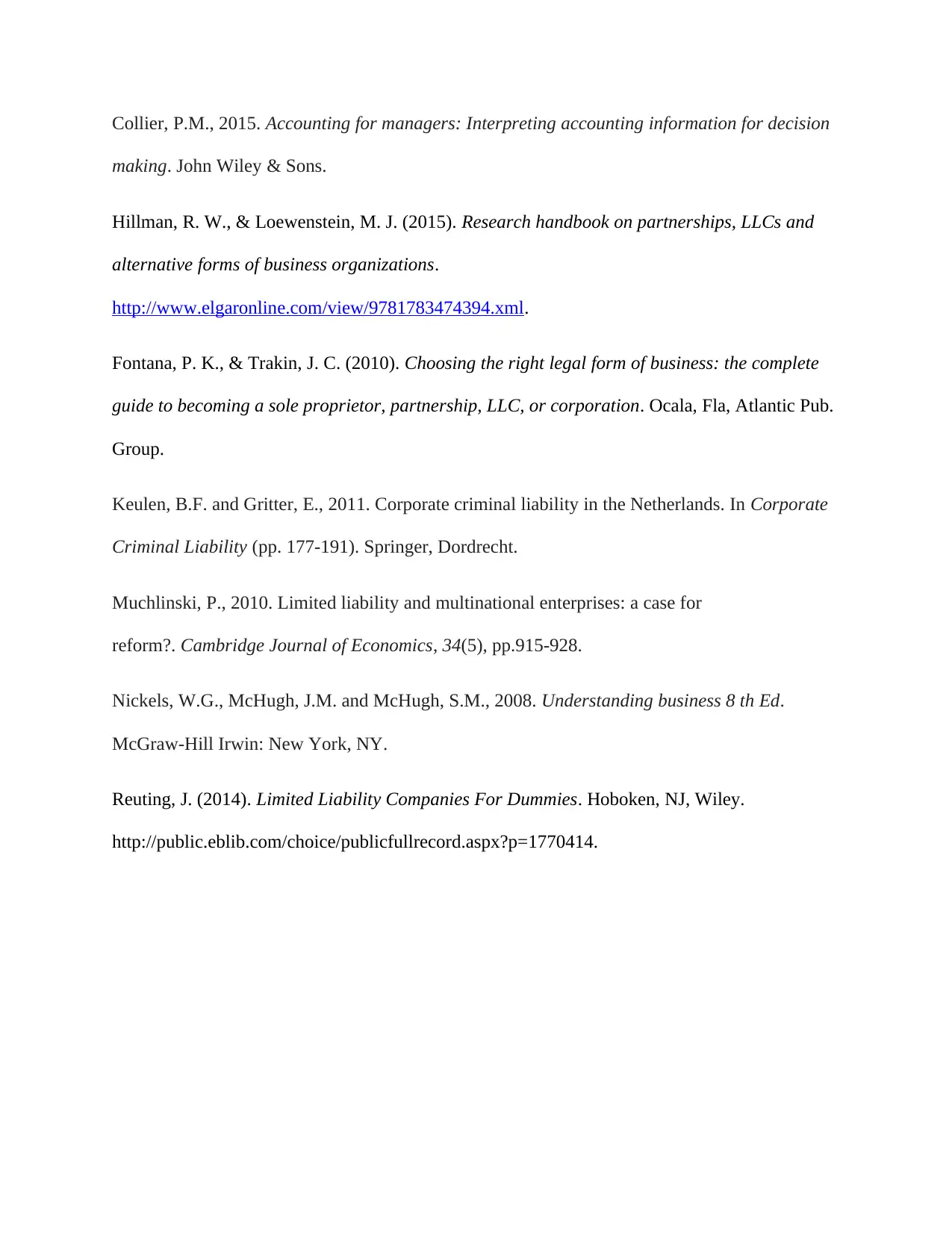
Collier, P.M., 2015. Accounting for managers: Interpreting accounting information for decision
making. John Wiley & Sons.
Hillman, R. W., & Loewenstein, M. J. (2015). Research handbook on partnerships, LLCs and
alternative forms of business organizations.
http://www.elgaronline.com/view/9781783474394.xml.
Fontana, P. K., & Trakin, J. C. (2010). Choosing the right legal form of business: the complete
guide to becoming a sole proprietor, partnership, LLC, or corporation. Ocala, Fla, Atlantic Pub.
Group.
Keulen, B.F. and Gritter, E., 2011. Corporate criminal liability in the Netherlands. In Corporate
Criminal Liability (pp. 177-191). Springer, Dordrecht.
Muchlinski, P., 2010. Limited liability and multinational enterprises: a case for
reform?. Cambridge Journal of Economics, 34(5), pp.915-928.
Nickels, W.G., McHugh, J.M. and McHugh, S.M., 2008. Understanding business 8 th Ed.
McGraw-Hill Irwin: New York, NY.
Reuting, J. (2014). Limited Liability Companies For Dummies. Hoboken, NJ, Wiley.
http://public.eblib.com/choice/publicfullrecord.aspx?p=1770414.
making. John Wiley & Sons.
Hillman, R. W., & Loewenstein, M. J. (2015). Research handbook on partnerships, LLCs and
alternative forms of business organizations.
http://www.elgaronline.com/view/9781783474394.xml.
Fontana, P. K., & Trakin, J. C. (2010). Choosing the right legal form of business: the complete
guide to becoming a sole proprietor, partnership, LLC, or corporation. Ocala, Fla, Atlantic Pub.
Group.
Keulen, B.F. and Gritter, E., 2011. Corporate criminal liability in the Netherlands. In Corporate
Criminal Liability (pp. 177-191). Springer, Dordrecht.
Muchlinski, P., 2010. Limited liability and multinational enterprises: a case for
reform?. Cambridge Journal of Economics, 34(5), pp.915-928.
Nickels, W.G., McHugh, J.M. and McHugh, S.M., 2008. Understanding business 8 th Ed.
McGraw-Hill Irwin: New York, NY.
Reuting, J. (2014). Limited Liability Companies For Dummies. Hoboken, NJ, Wiley.
http://public.eblib.com/choice/publicfullrecord.aspx?p=1770414.
⊘ This is a preview!⊘
Do you want full access?
Subscribe today to unlock all pages.

Trusted by 1+ million students worldwide

1 out of 10
Related Documents
Your All-in-One AI-Powered Toolkit for Academic Success.
+13062052269
info@desklib.com
Available 24*7 on WhatsApp / Email
![[object Object]](/_next/static/media/star-bottom.7253800d.svg)
Unlock your academic potential
Copyright © 2020–2025 A2Z Services. All Rights Reserved. Developed and managed by ZUCOL.




